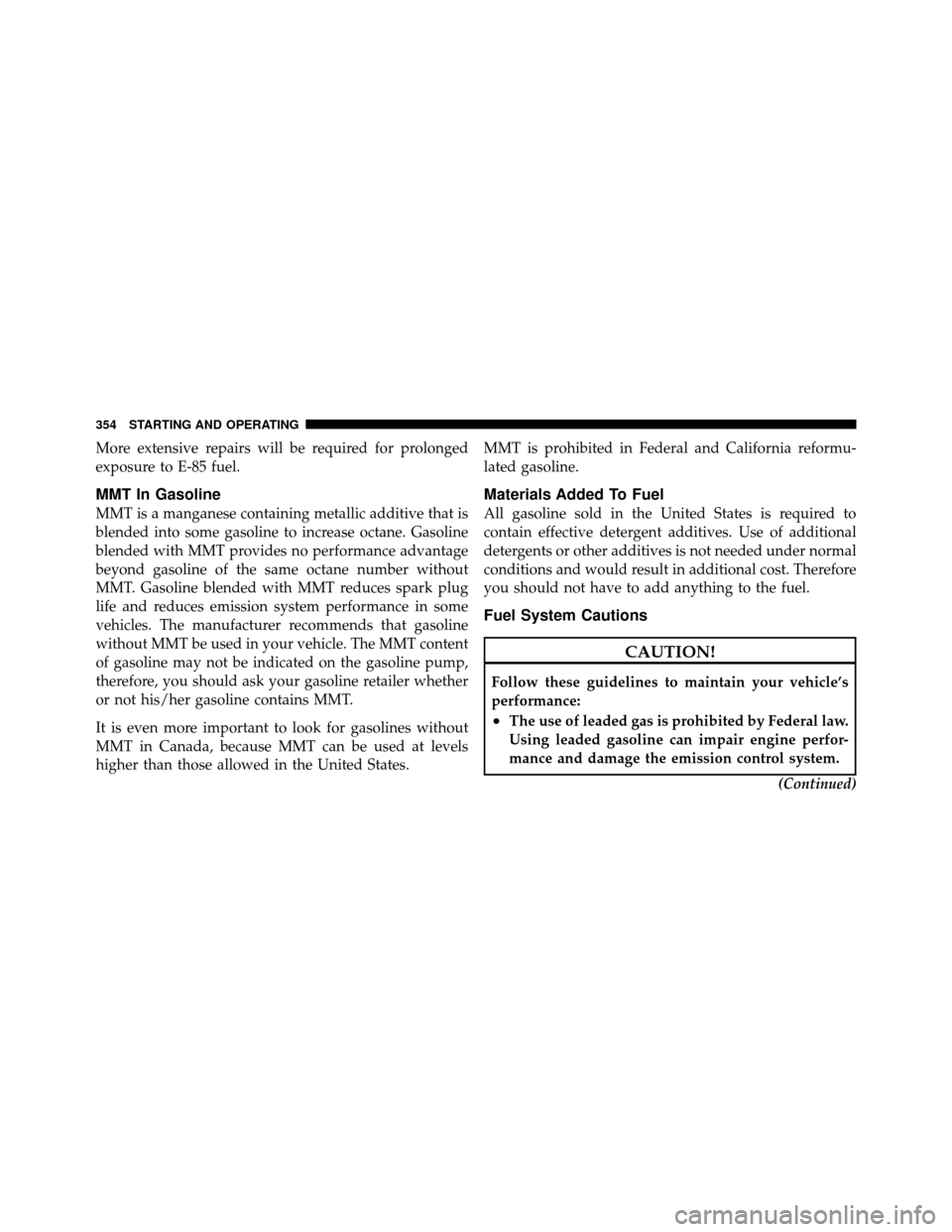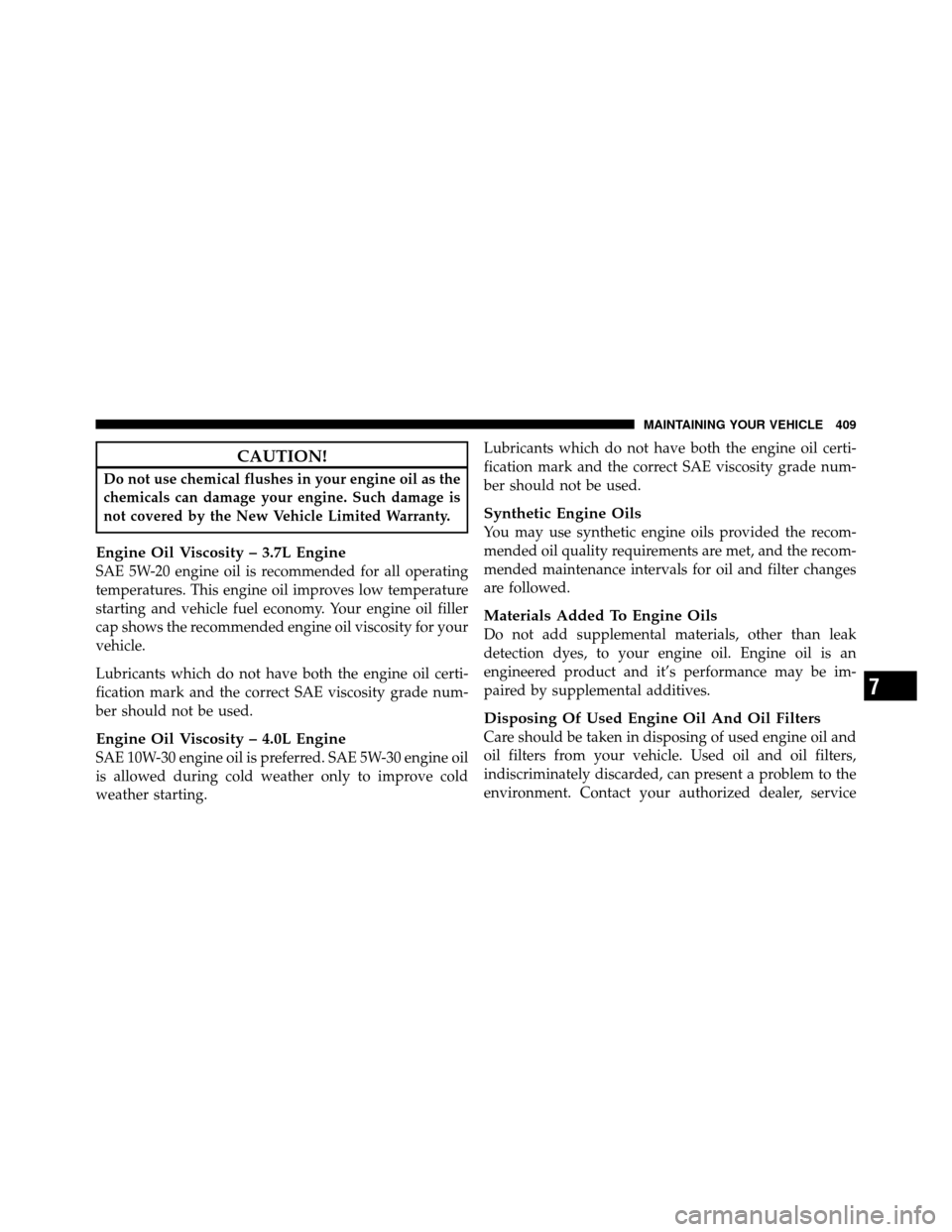Page 357 of 497

More extensive repairs will be required for prolonged
exposure to E-85 fuel.
MMT In Gasoline
MMT is a manganese containing metallic additive that is
blended into some gasoline to increase octane. Gasoline
blended with MMT provides no performance advantage
beyond gasoline of the same octane number without
MMT. Gasoline blended with MMT reduces spark plug
life and reduces emission system performance in some
vehicles. The manufacturer recommends that gasoline
without MMT be used in your vehicle. The MMT content
of gasoline may not be indicated on the gasoline pump,
therefore, you should ask your gasoline retailer whether
or not his/her gasoline contains MMT.
It is even more important to look for gasolines without
MMT in Canada, because MMT can be used at levels
higher than those allowed in the United States.MMT is prohibited in Federal and California reformu-
lated gasoline.
Materials Added To Fuel
All gasoline sold in the United States is required to
contain effective detergent additives. Use of additional
detergents or other additives is not needed under normal
conditions and would result in additional cost. Therefore
you should not have to add anything to the fuel.
Fuel System Cautions
CAUTION!
Follow these guidelines to maintain your vehicle’s
performance:
•The use of leaded gas is prohibited by Federal law.
Using leaded gasoline can impair engine perfor-
mance and damage the emission control system.
(Continued)
354 STARTING AND OPERATING
Page 358 of 497

CAUTION! (Continued)
•An out-of-tune engine or certain fuel or ignition
malfunctions, can cause the catalytic converter to
overheat. If you notice a pungent burning odor or
some light smoke, your engine may be out of tune
or malfunctioning and may require immediate
service. Contact your authorized dealer for service
assistance.
•The use of fuel additives which are now being
sold as octane enhancers is not recommended.
Most of these products contain high concentra-
tions of methanol. Fuel system damage or vehicle
performance problems resulting from the use of
such fuels or additives is not the responsibility of
the manufacturer.
NOTE: Intentional tampering with emissions control
systems can result in civil penalties being assessed
against you.
Carbon Monoxide Warnings
WARNING!
Carbon monoxide (CO) in exhaust gases is deadly.
Follow the precautions below to prevent carbon
monoxide poisoning:
•Do not inhale exhaust gases. They contain carbon
monoxide, a colorless and odorless gas which can
kill. Never run the engine in a closed area such as
a garage, and never sit in a parked vehicle with the
engine running for an extended period. If the
vehicle is stopped in an open area with the engine
running for more than a short period, adjust the
ventilation system to force fresh, outside air into
the vehicle.
(Continued)
5
STARTING AND OPERATING 355
Page 412 of 497

CAUTION!
Do not use chemical flushes in your engine oil as the
chemicals can damage your engine. Such damage is
not covered by the New Vehicle Limited Warranty.
Engine Oil Viscosity – 3.7L Engine
SAE 5W-20 engine oil is recommended for all operating
temperatures. This engine oil improves low temperature
starting and vehicle fuel economy. Your engine oil filler
cap shows the recommended engine oil viscosity for your
vehicle.
Lubricants which do not have both the engine oil certi-
fication mark and the correct SAE viscosity grade num-
ber should not be used.
Engine Oil Viscosity – 4.0L Engine
SAE 10W-30 engine oil is preferred. SAE 5W-30 engine oil
is allowed during cold weather only to improve cold
weather starting.Lubricants which do not have both the engine oil certi-
fication mark and the correct SAE viscosity grade num-
ber should not be used.
Synthetic Engine Oils
You may use synthetic engine oils provided the recom-
mended oil quality requirements are met, and the recom-
mended maintenance intervals for oil and filter changes
are followed.
Materials Added To Engine Oils
Do not add supplemental materials, other than leak
detection dyes, to your engine oil. Engine oil is an
engineered product and it’s performance may be im-
paired by supplemental additives.
Disposing Of Used Engine Oil And Oil Filters
Care should be taken in disposing of used engine oil and
oil filters from your vehicle. Used oil and oil filters,
indiscriminately discarded, can present a problem to the
environment. Contact your authorized dealer, service
7
MAINTAINING YOUR VEHICLE 409
Page 478 of 497

Fluid Level Check.................... 425
Fluid Type ...................... 424,445
Special Additives ..................... 425
Torque Converter .................. 299,304
Autostick ............................. 301
Auxiliary Electrical Outlet (Power Outlet) ...... 179
Auxiliary Power Outlet ................... 179
Axle Fluid ............................. 445
B-Pillar Location ........................ 325
Battery ............................... 411
Keyless Transmitter Replacement (RKE) ..... 24
Belts, Seat ............................ 43,89
Body Mechanism Lubrication ............... 413
Brake Assist System ...................... 315
Brake Control System, Electronic ............. 313
Brake Fluid ............................ 445
Brake System ........................... 422
Anti-Lock (ABS) ................... 31 1,314Master Cylinder
..................... 423
Parking ........................... 309
Warning Light ....................... 202
Brake, Parking .......................... 309
Brake/Transmission Interlock ............... 295
Break-In Recommendations, New Vehicle ........ 86
Bulb Replacement ....................... 438
Bulbs, Light .......................... 91,438
Calibration, Compass .................. 215,222
Capacities, Fluid ........................ 443
Caps, Filler Fuel .............................. 356
Power Steering ...................... 308
Car Washes ............................ 428
Carbon Monoxide Warning ...............88,355
Cargo (Vehicle Loading) ................... 358
Cargo Area Features ...................... 185
10
INDEX 475